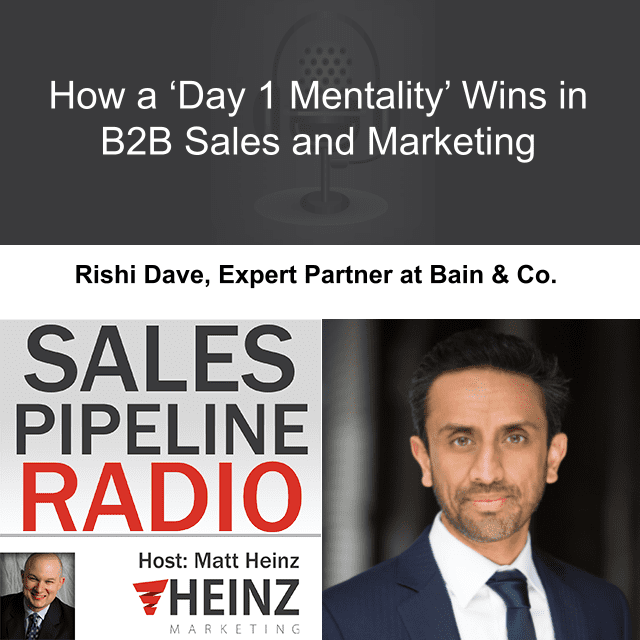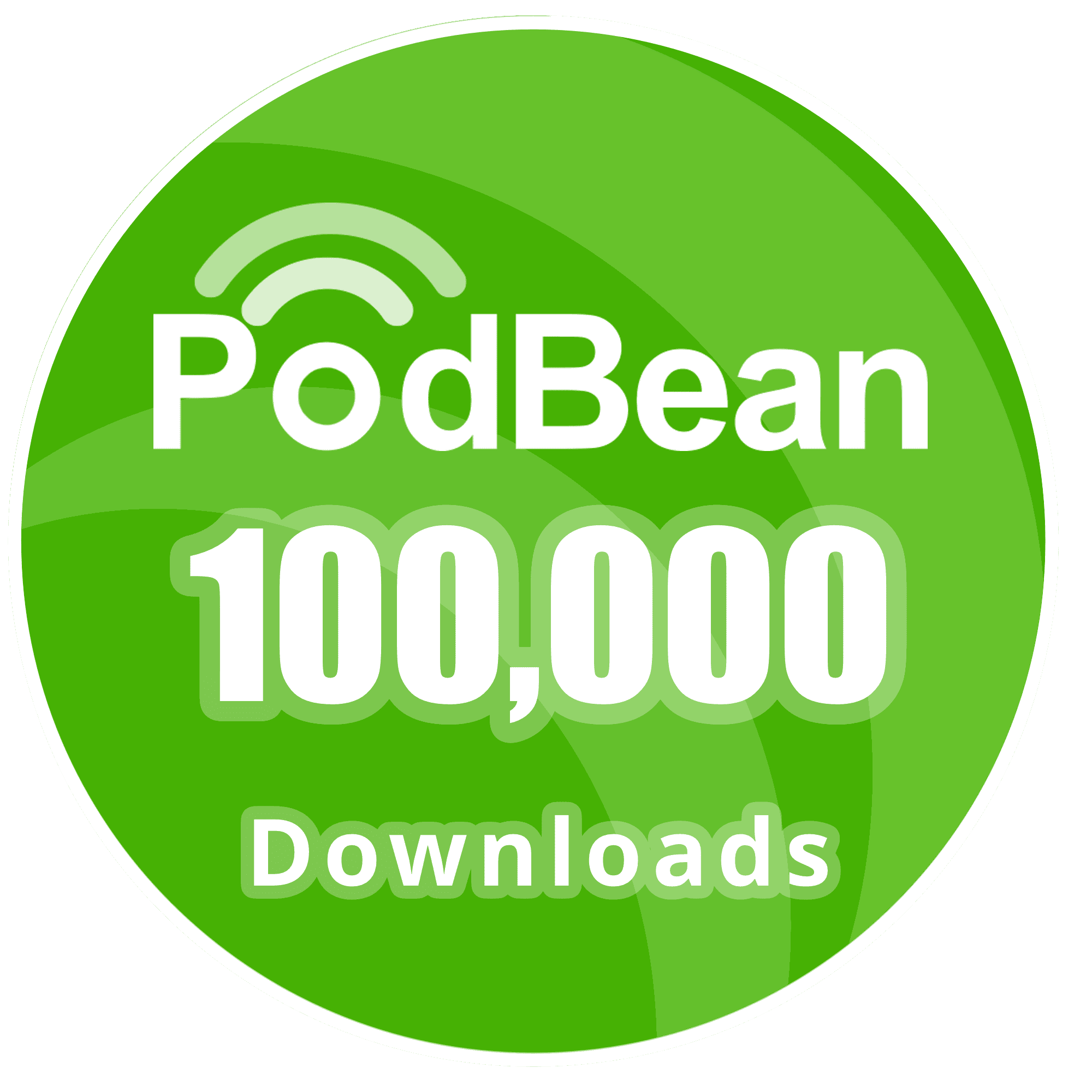Sales Pipeline Radio, Episode 334: Q & A with Rishi Dave

By Matt Heinz, President of Heinz Marketing
If you’re not already subscribed to Sales Pipeline Radio or listening live every Thursday at 11:30 a.m Pacific on LinkedIn (also on demand) you can find the transcription and recording here on the blog every Monday morning. The show is less than 30 minutes, fast-paced and full of actionable advice, best practices and more for B2B sales & marketing professionals.
We cover a wide range of topics, with a focus on sales development and inside sales priorities. You can subscribe right at Sales Pipeline Radio and/or listen to full recordings of past shows everywhere you listen to podcasts! Spotify, iTunes, Blubrry, Google Play, iHeartRADIO, Stitcher and now on Amazon music. You can even ask Siri, Alexa and Google or search on Audible!
This week’s show is entitled, “How a ‘Day 1 Mentality’ Wins in B2B Sales and Marketing“ and my guest is Rishi Dave, Expert Partner at Bain & Co.
Tune in to hear more about:
- The Day One mentality of B2B buying
- Building credibility and attention with decision makers before they’re ready to buy
- How do RFPs play into the Day One mentality, and should we even be using them?
- The impact and importance of communities given specific data
Watch the video, listen in below and/or read the transcript:
Matt: All right. Welcome everybody to another episode of Sales Pipeline Radio. I am your host, Matt Heinz, excited to have you here, live from the farmhouse basement today. Just excited to have you here and excited to get started on the last month of Q1. Rishi, we were just watching the Rose Bowl parade and now we’re getting towards the end of Q1. I don’t know. The older I get, the more I think time goes faster. There must be some science around that somewhere. But anyway, excited to have y’all here.
If you are watching this episode live on LinkedIn, we’re so happy to have you here in the middle of your workday. If you’re watching live, you have an opportunity to be part of the show. If you want to make a comment about what you’re hearing today, if you want to ask a question of our guest today, we’re going to be talking about the Day One mentality of B2B buying, what it is, and why it’s so important. So, excited to have that today. If you have a question, if you have a comment, you can be part of the show. Throw that in and we’ll get you up on screen. If you are listening or watching on demand, thanks so much for checking us out. Every episode of Sales Pipeline Radio for the past six, seven years is available on salespipelineradio.com on demand.
I’m very excited to have today, Rishi Dave, of Bain & Company. He is the Commercial Excellence Practice Leader, longtime CMO, from a number of different roles in companies. You’ve probably have seen or heard his name, maybe seen him on stage at B2B events in the past. But Rishi, thanks so much for joining us.
Rishi: Oh, it’s great to be here. And Matt, great to see you again. I’ve seen you over 20+ years at everything, so it’s great to just see you again.
Matt: Yeah, well, I guess we are getting that old now, right?
Rishi: We are.
Matt: You started to talk about those years, boy, just it is. And it’s a small industry we work in for sure.
Rishi: It is.
Matt: But I was excited to hear from you and to hear what you’re working on these days, consulting with a lot of companies around the increasing complexity of B2B marketing, buying journeys, combining sales processes with buying journeys. And of all the stuff that I know I’ve seen you produce and talk about the last few months, this idea of this Day One mentality stood out to me. And I think, for those of you in tech, you might think of Day One mentality as sort of the Amazon mentality, similar but a little different in the B2B context.
So, maybe let’s just start with that. What is that Day One mentality? How did you find this? And why is it important for us to understand?
Rishi: Yeah, it was a amazing find that we kind of fell upon when we were doing research.
We had done a lot of research jointly with Google on B2B buying and how it’s changed. And the initial wave of research is stuff that everyone now takes for granted, things like B2B buyers digitally nurture themselves, sales and marketing disconnects, all of that. But we did another set of research after that where we said, “Well, let’s really dig in on the buyer journey today to find actual insights. Let’s cut it by industry, cut it by different purchase sizes and different B2B buyers,” essentially different size B2B buyers.
And so we did a whole bunch of research there and got a whole bunch of findings. But the one that was most interesting was this concept of a Day One list. So, what it exactly is, it’s actually very practical and common sense, but until you think about it and actually see the numbers, it really hits you.
What we found is that, regardless of industry, regardless of kind of company size or purchase size, and regardless of how complex the procurement process is of a B2B buyer, we found one thing that’s consistent. When the B2B buyer is ready to buy, they have in their mind a list of vendors that they put down on that Day One list. And depending on the industry, it’s within 86-90% of buyers, they have that Day One list and they put that down. Then they may go through a complex procurement process, but roughly 90% of the time at the end of that procurement process, they end up buying off that Day One list. And that was no matter whether the procurement process was short, long, no matter how many people were involved. They’ll sometimes add one or two vendors to that list through that procurement process. But 90% of the time, give or take a few percentage points, depending on industry, they’ll end up buying off that Day One list. And so, that was just a big insight for us. And when we talk to companies, that’s something that people immediately attach on and then they kind of say, “Okay, so what does that really practically mean?:
Matt: Yeah, I think if you’re watching this today and you feel a breeze, it is the brand and content people violently nodding their heads in agreement. Because they’re like, “I told you so. This is why what we do is so important.” And so, let’s talk a little. Let’s unpack this a little bit, right? Because I mean, this has an impact on a lot of things. It has an impact on how we think about building credibility and attention with decision makers before they’re ready to buy. It also has an impact on the activities that we have traditionally thought were valuable uses of time. I’d love to talk about the old RFP and the idea that of like, if I get an RFP, if I didn’t know the company producing it, I’m probably already way behind.
Rishi: Yes.
Matt: Talk about what the Day One mentality means about RFPs and whether or not we should be using them.
Rishi: Yes. Well, I mean, we found that three things get you on the Day One list, and an RFP is not one of them. In no particular order, these three things. One is the B2B buyer, when they were at another company, they used you and they had a good experience. And so, when they moved to their new company, they already knew you and they put you on that list. Number two is, somebody else who they trust recommended you at some point. And then thirdly is exactly what you said. They were made aware of your company and what you do before they were even ready to buy, whether it’s digitally or they were already talking to sellers or they were already talking to somebody who was talking to them about what you do. And so, those three things were the three big buckets.
Ultimately what it means is what you just said, which is branding, content, sellers talking to B2B buyers that are on their target list before they’re even ready to buy and educating them, et cetera. But it also means keep your customers happy because executives move from company to company constantly now. And they’re going to put you on that list every single time if they love you and they’re going to recommend you. So, it’s like, keep the customers, keep your clients happy, give them a great experience, and make people aware of you before they ready buy.
Matt: Talking today on Sales Pipeline Radio with Rishi Dave. He’s the head of commercial insights for Bain & Company. And this idea that, again, this is important. 80 to 90% of B2B buyers have a Day One list of vendors they’re already considering and 90% of them pick the vendors on that day one list. The implications of this are profound.
One of the other areas I want to discuss around this is the idea of generating leads from the right people at the right company before they’re ready to buy. We had a conversation last week in a CMO group about BDR management best practices. And we found several CMOs that are managing BDRs are not… I mean, obviously if you can set an appointment for a prospect that’s ready to buy, great. But the other strategy is to really do what a couple of them called value deposits to create a positive impression with that prospect to create some value through that BDR motion. I mean, you’re spending money on them and you want them to set an appointment, but you’re also spending money on white papers and events and other things that are meant to generate that pre-buying journey, at least awareness, if not intent, if not consideration. Talk a little bit about what this means for what we have traditionally used as pipeline generators and how we can adjust that strategy for people that aren’t ready for that pipeline.
Rishi: Yeah, well, the failure point that we see consistently in what you describe is actually not having a robust understanding of who you’re targeting. Today, with all these third party data companies that are out there, you know every single company that’s out there definitely in the US and Europe at least, and to some degree in Asia, as well. And you can’t pre-nurture everyone at the same level. So, many companies do not have a clear understanding at a company by company level about where the biggest opportunities are for them. And so, you always start at the basics, which is, do you have that bottoms-up company level database where you know your share of wallet in those companies and what the opportunity is within those companies? Or where they’re not? And that prioritized list? That allows you to get very precise on how you, what you described, pre-nurture or do BDR outbounding, et cetera.
So, obviously if some of them are big companies, then it’s actually worth sellers just pre-nurturing themselves. Other times you need BDRs, other times you need inside. Obviously, marketing plays a role in all types of companies. But the more precise and focus you can be, the more effective you can be in that pre-nurturing. And there’s two failure points. One is you don’t have that bottoms-up feeling, bottoms-up database. And secondly, sales and marketing are operating off two totally different databases and they’re not coordinating the motions to go after those same set of accounts.
You have to have the same database and then sales and market have to coordinate the motions against those accounts.
Matt: Super interesting, I think you brought up making your customers happy and continuing to get business. I think even internally for our tiny little professional services firm, we have a goal for past client business we want in the pipeline, what percent of our pipeline are past clients. And we don’t just look at past clients’ accounts. We also count past executive sponsors, so people that had been CMO at one company, have moved to a new company, but bring us with them or had the positive impression of bringing that with them.
The other piece that I think is really prescient right now, we see a lot of companies talking about communities and community-led growth initiatives and either creating or leveraging peer communities. And it seems like those recommendations, those referral engines, people think of it historically as the dark funnel. That ain’t dark. You can see it’s out there. Right?
And so, talk about the impact and the importance of communities given this data.
Rishi: Yeah, well, one thing you said at the beginning was very critical. We are now mathematically deconstructing, which is back to your thing, how much of your incremental customers, incremental growth is coming through what we call earned growth, which is growth that you earn because they’ve heard of you from a brand perspective, somebody recommended you to them, they had used you before, et cetera. How much of your growth is coming from that versus growth that you’re paying for?
There are easy ways to mathematically measure that. And over time, you should have a good percentage, to your point, as you just described with your own company, of your growth coming from this earned growth. So, it’s very important for you to understand how many of your customers are you earning versus how many you’re paying for. Obviously, you still have to pay for customers, but you want to earn more. And that’s where the pre-nurturing, the branding, the content, the relationships, the influencers, all that becomes very critical.
Now, your question on communities, it obviously depends on what industry you’re in and the company that you’re in, et cetera. For example, in tech with tech-oriented companies, you’re selling to developers. Those communities are super critical because that’s where you get a majority of referrals. So, it just depends on the nature of your industry and where they credibly go. I work with tech companies where those digital communities are critical. I also work with industrial companies where they’re less so and it’s more of a person to person referral. You have to just really know that and know what it’s going to take to drive that earned growth. And also, you can leverage where in the past you’ve been successful.
Matt: Yeah, yeah. I want to go back because we’re just a few more minutes here talking about this topic. I want to go back to those people that were nodding vehemently, like the brand folks, the content folks, where, if you’re creating your own earned traffic, earned attention, that isn’t immediately measured on pipeline. But I mean, I’m a math marketer, right? And I like to think about things in terms of justifying its existence, even if it’s not a direct response to something you can buy a beer with.
Are there ways to mathematically create a formula that says, “Here’s the impact. Here’s the work I’m doing to invest in those relationships.” Do we do that based on an expected future pipeline? Can we justify it based on expected future conversion rates and faster sales cycles? What have you seen in the wild?
Rishi: Yeah, we’ve built a whole practice on this. And I mean, obviously Bain invented NPS, so this is the next evolution. But to boil it down to an overly simple level, but it actually works, look at the customers you’re earning today and ask them. Why did you look at us in the first place?
And we have surveys that we’ve tested over time that really deconstruct what’s earned and what’s not. But let me make it super basic. Look at your customers you’re getting now and simply ask them, “Did you come in because you’re responding to an ad? Or did you come in because somebody referred you? Or did you come in because you worked for us?” There’s a lot of questions you can ask on why they came into you in the first place. And that’ll help you get an initial feel for how many of these customers you’re earning and how much you’re paying for. And then look at what’s been successful in earning those customers and do more of that. Now, I’m overly simplifying. We’ve made that very programmatic and scalable, but that, at the most basic level, gives you actually surprisingly a pretty robust understanding of that.
Matt: Yeah, that’s really interesting. And I think when you think about these more complex deal cycles where you’ve got multiple members of a buying committee, there may be one or two of those people that you could impact. But part of your job then, even before the buying process begins, is to build some internal consensus. I think of a commitment to change, which is going to precede buying or considering your product, is still consensus building internally. And there’s absolutely a role for creating preference for that Day One list internally, having internal circulation of your ideas and values as part of this.
Just as we wrap up here, last question, maybe for you is around the change management component of this, right? Because I think intuitively this makes a lot of sense. And I know you’ve got a lot of data and some case studies behind it. But there’s a lot of companies out there that still worship the altar of the marketing qualified lead, right?
Rishi: Yeah.
Matt: And the sales team loves it, the leadership team loves it, the board loves it. And so everything gets sort of narrowed down to, how many MQLs did it generate, which is a short-term and maybe shortsighted approach to thinking about how to build sustained long-term, predictable pipeline. If other people are sort of saying this makes sense, how do you start to build that change management into your organization so you can think in a more complex, nuanced, successful, scalable way about building future pipeline?
Rishi: Yeah. Well, one way that has been very effective is what I describe, which is just look at where your existing customers came. Because for example, you may think based on your mathematics and analytics that these customers came. And they may have come as an MQL. But when you actually ask them why they came in the first place, it’s not because they saw a content piece, clicked on it, and then converted in the lead. Before they even got to that point, they got a referral, they heard of you already, it was a branding element or some kind of earned element. And then they said, “Okay, now I’m ready to buy. Let me go in and fill out a lead form.”
And so, starting to gather that data on the customers you’re getting today and showing that, “Look, what’s actually making them come in is brand, is referrals, is content, is all of this,” and not the traditional kind of short term MQL, and building that database of your current customers becomes very effective and eye-opening for the board, for executives, et cetera. So, all of that becomes very effective.
And then, there’s obviously a lot of other things that we do already, which is like, look at your organic traffic, look at how that’s growing. There’s a lot of short stuff that we can use to measure how much brand recognition you have, as well. But both those things have worked really well. It’s both looking at the organic traffic, your branded traffic coming from search, but also looking at what’s truly driving your new customers today.
Matt: Yep. This is awesome. I mean, so much to unpack here, and hopefully we’ve sort of lit a bit of a fuse for people listening to say, “Okay, what does this mean for their organization? What can they do internally?” I know that you’ve got a lot of content up on your profile on bain.com, on your LinkedIn profile, as well. You’ve got some stuff up on Harvard Business Review and you’ve been interviewed, quoted and written a lot. Where can people find more about this? Where should we go? Where should they go?
Rishi: Yeah, so you can definitely follow me on LinkedIn. You can definitely follow me on Twitter @rishipdave, so R-I-S-H-I-P-D-A-V-E. And then, just go on to bain.com and I have a whole profile up there and you can see all the articles I’ve written, as well.
Matt: Awesome. We will put those links in the show notes as well so y’all have access to those. And yeah, thank you so much, Rishi. This has been great. I mean, I think for people that have been doing B2B marketing, this intuitively make sense. But to have some data and some real frameworks behind it to try to not only operationalize it, but also create some of the change management required internally to create an operational shift across departments and perspectives and cloud organizations. So, thank you very much for the insights and thanks for joining us today. I know you’re busy.
Rishi: Yep. No, thank you. And I’ve followed you over the last 20+ years and your content has been fantastic. And I’m sure your audience sees that, as well. You’ve lived this, so thank you.
Matt: Thank you very much.
Well, thank you everyone for watching and listening today. Thanks for joining this episode of Sales Pipeline Radio. My name is Matt Heinz. We’ll see you next week. Take care.
Listen to the Latest Episodes:






